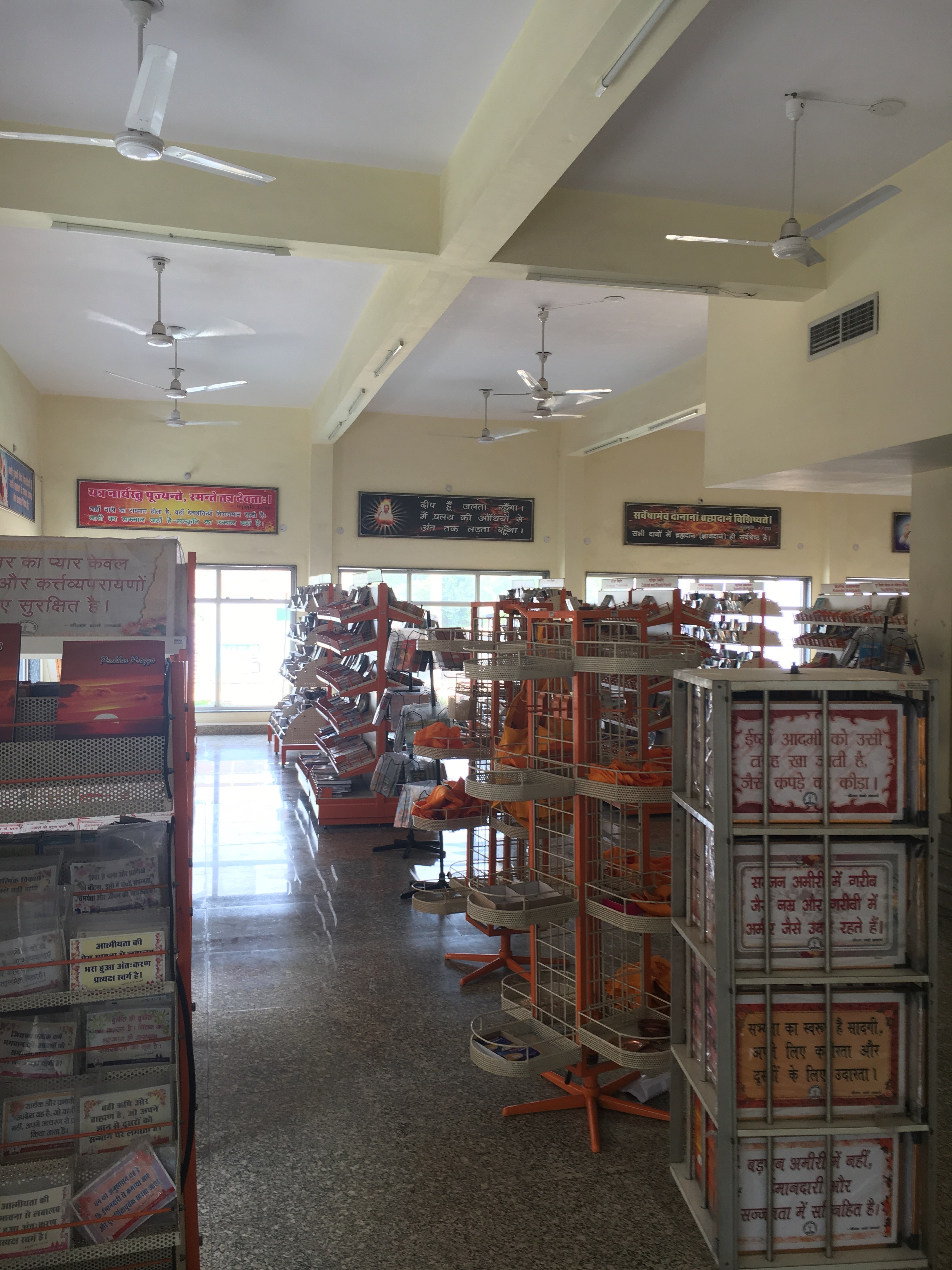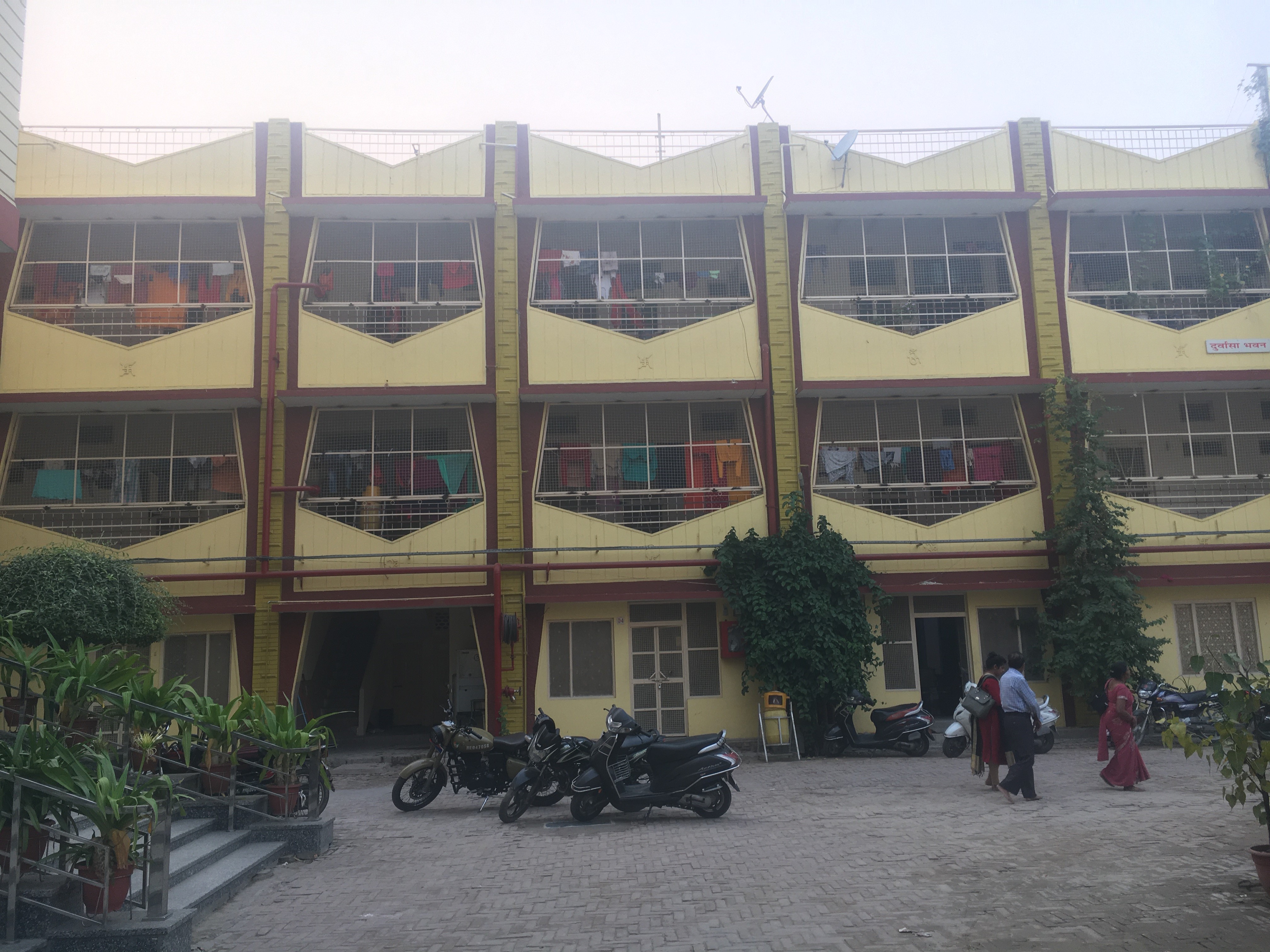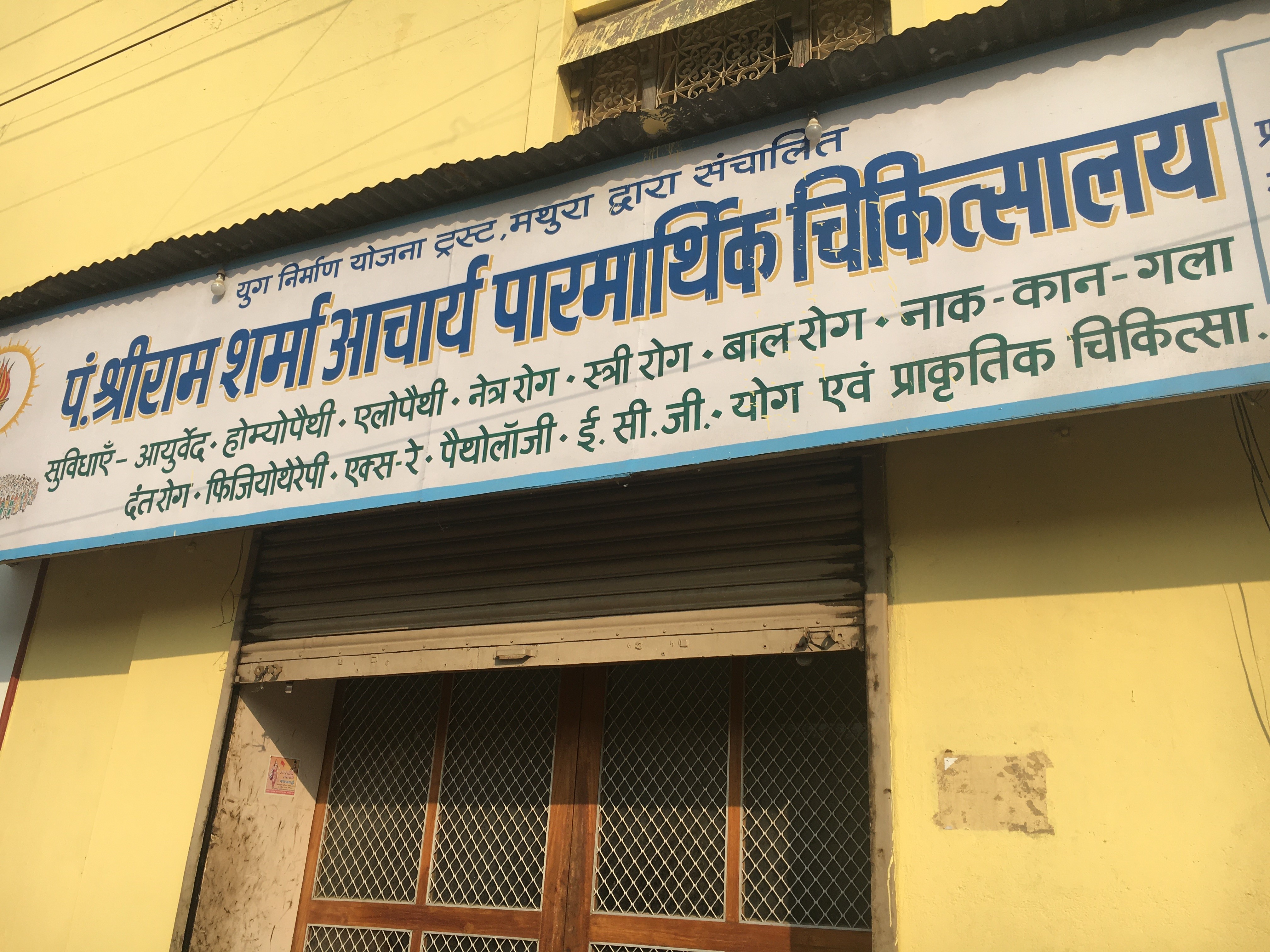Gayatri Tapobhumi
Gayatri Pariwar
Bookstore
As the Mathura Gayatri Pariwar is in charge of producing most of the organization’s print publications, it makes sense that the Tapobhumi features an impressive bookstore where visitors can purchase them. Yet literature is not the extent of the items for sale: calendars, posters, bumper stickers, keychains, CDs, DVDs, and USB sticks contain excerpts or full recordings of Guru ji’s lectures; worship items are for sale, including mālā beads, pictures of Gayatri Devi, incense, havan kuṇḍs, wooden ladles to use with them, and even havan sāmagrī and ghee produced at the nearby printing press campus; Ayurvedic medicines are available for purchase, which I have been told are made at the Akhand Jyoti Press grounds. Clearly labeled metal aisles make browsing by subject an easy process, and freely distributed product catalogues (which also include a summarized history, timeline, and point-by-point mission statement of the organization) are available to help the rare customer who would rather not ask the two or three receptionists sitting at any given time. The bookstore itself is three stories high, but only the ground floor is open to customers. I imagine the upper stories are for keeping extra inventory, whether for daily sales or for regularly demanded bulk orders.
Vidyalaya
The northern portion of Gayatri Tapobhumi campus features a vocational school for secondary school boys. The course lasts ten months, from July to April, and includes subjects ranging from “moral education,” ritual procedure, music, yoga, production of household goods (such as soap, incense, jam, etc.), computer courses, electronics, and press publication. For the duration of their studies, students are expected to live at the Gayatri Tapobhumi, and live according to its rules (daily morning yajña, vegetarian food – no onions or garlic – and alloted time for chanting and writing the Gayatri Mantra). During the time I spent at the Tapobhumi, there were twenty-four boys enrolled in the course, who stood out in appearance because of olive-green khaki uniforms that resembled police uniforms, quite different from the saffron kurtas and dhotis worn by the senior Gayatri Pariwar members.
Important to note is that the vidyālaya stands alone on the northern edge of the Tapobhumi campus, and is off-limits to visitors (at least to foreign researchers). Even when invited by several students to view their classrooms on a Sunday afternoon, I was harshly scolded and led from the area by the Tapobhumi’s security guard.
Tapobhumi Lodgings
The southern half of the Tapobhumi complex is bordered by residential buildings. When asked about the housing capacity of these strucutres, Tapobhumi workers gave me figures ranging between 350 and 700. In all likelihood, the lower number most accurately reflects the number of people currently able to reside on the Tapobhumi grounds, for at least one of the residential halls was torn down in June in order to make room for the renovated temple area, part of a three-year project to renovate the Gayatri Tapobhumi. Even if a full 700 people were able to stay at the Tapobhumi at a given time, more space would be required for the influx of people during several celebrations, retreats, and workshops that take place there every year. Although there will never again be a 1000-kuṇḍ mahāyajña in Mathura such as there was in 1958, which allegedly drew over 400,000 visitors in five days, it is not uncommon for annual and semi-annual functions to draw fifteen-hundred participants or more to the Tapobhumi grounds.1 On these occasions, guests are lodged at the Tapobhumi, at the nearby press, and in various dharmshalas in the area (including that of the Birla Mandir next-door to the press). Housing is free for those who stay in the Gayatri Pariwar’s campuses, although prior registration is required. The tacit understanding, of course, is that visitors will donate a modest sum of money to the Gayatri Pariwar upon their departure.
Medical Clinic
Open since 2009, the Gayatri Tapobhumi’s medical clinic provides consultations and treatments according to “every kind of ‘-pathy,’” from Ayurveda, allopathy, homeopathy, physiotherapy, the yoga, naturopathy, and magnetic therapy (as well as dental, eye, and ENT care). There is a resident doctor for each of these medical specialties except for an eye doctor (who left Mathura a few months back) and an ENT doctor (which there had never been since the clinic’s opening). There used to have been a pathology ward as well, but because of a botched treatment, the ward had since closed at the request of the Tapobhumi administration. With its own streetside entrance, the Tapobhumi Chikitsalaya offers its services to the local community on a “no profit, no loss” model. According to the in-charge of the clinic, an average of 200-250 patients visit every day.
The medicines available at the Chikitsalaya are sourced differently. Allopathic and naturopathic medicines are not stocked at the clinic. In the case of allopathy, prescription slips are given to patients who can visit local pharmacies, and in the case of naturopathy, the medicines are nothing but items freely attainable in nature: water, air, soil, etc. Homeopathic medicines are bought from local retailers, and the Ayurvedic remedies are manufactured by the Gayatri Pariwar itself, presumably at the Akhaṇḍ Jyoti Press.2 Although many of these Ayurvedic medicines are available all year, some are seasonally manufactured, such as the Gayatri Tapobhumi’s Chyawanprash which is sold at the bookstore during the winter months.
- In preparation for this immense function, eight semi-permanent “townships” were allegedly constructed on over three kilometers of land stretching northward along the Mathura-Vrindavan road from the Gayatri Tapobhumi, not including a 7 km2 lot for the 1000 havan kuṇds to be used in the ritual. See Lilapati Sharma, Gurudev - Prophet of a New Era (Mathura: Yug Nirman Yojana Vistar Trust) 2009, 12-22. ↩
- I say presumably because I have not in fact seen where they are manufactured. The in-charge of the clinic told me they are manufactured at the press, and the manager of the main press campus said that no such Ayurvedic medicines were produced under his watch – he conjectured that they must be produced at the nearby Akhaṇḍ Jyoti Press. ↩


